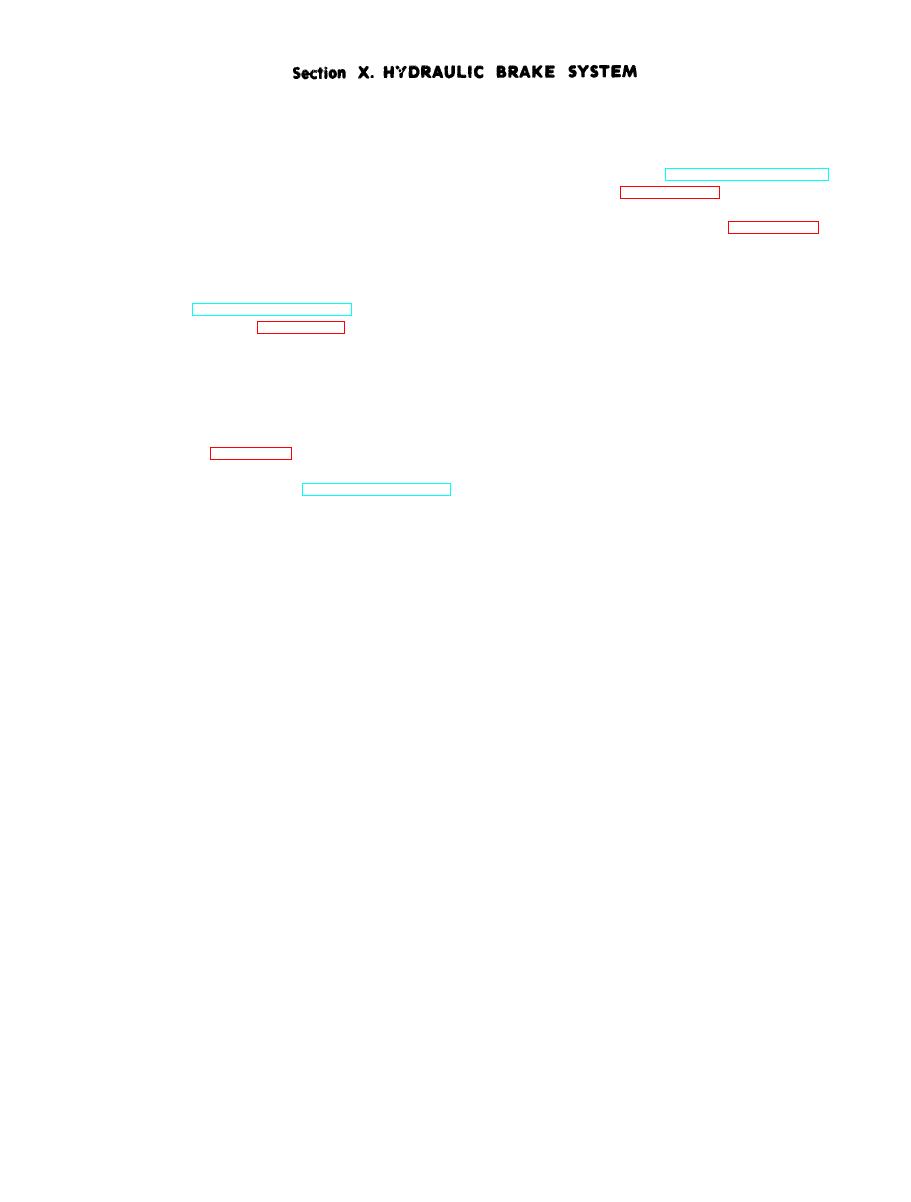 |
|||
|
|
|||
|
Page Title:
Section X. Hydraulic Brake System |
|
||
| ||||||||||
|
|
 condition is reached. Continued operation in this
3-48. General
condition will damage brake structure..
This section contains information on the main-
b. R e m o v a l .
tenance of the hydraulic brake system. This in-
(1) Remove wheel (TM 10-3930-243-12).
cludes the hand brake assembly, the hydraulic
(2) Refer to figure 3-106 (1 thru 40) and
brake system, hydraulic pump, brake valve, ad-
remove the brake assembly in numerical sequence.
juster, accumulator, and the hydraulic oil tank.
disassemble the brake assembly as follows:
a. General. The parking brake assembly is
(1)
Hold
the
brake
either
vertically
or
mounted to the transmission and connected to a
horizontally so that both frames (8 and 9) are
c o n t r o l lever handle on the right hand side of the
exposed.
driver's seat (TM 10-3930-243-12).
( 2 ) Place a screwdriver against the hook of the
retracting spring (7) and with a sharp blow,
step 9, and remove the parking brake assembly.
d i s e n g a g e spring from the frame. Drive the springs
c. Inspection.
through the brake and out of the assembly.
( 1 ) Inspect the brake shoe for excessive wear:
( 3 ) Lift the block and shoe assembly (5) from
( 2 ) Inspect all hardware for breaks or damage.
the frame.
(3) Replace a defective part.
(4) Remove brake frame bolts (2).
d. Installation.
( 5 ) Use center punch to mark upper and lower
( 1 ) Refer to figure 3-97, steps 52 thru 54, and
frames for same location on reassembly and lift
install parking brake assembly.
upper half of frame from torque plate (11).
(2) Adjust parking brake (TM 10-3930-243-
(6) Slide expander tube (12) and inlet con-
12).
nection (10) from the torque plate.
NOTE
a. General. The brake assembly on the rough
If expander tube is stuck to the torque plate, work a
thin piece of steel between the torque plate and ex-
terrain forklift is the expander tube brake, 360
pander tube and draw it around the plate to free tube.
segmented, shoe type actuated by an expander
tube. Its components include a cast torque plate
(7) Remove inlet connection from nozzle of
upon which the expander tube is mounted and an
e x p a n d e r tube, and remove O-rings (3 and 4) from
inlet connection into which the nozzle of the ex-
nozzle.
Inspection, Repair, and
pander tube is inserted. Steel side frames with
d. Cleaning,
w e l d e d steel torque bars are attached to both sides
Replacement.
o f the torque plate. Brake linings mounted on steel
(1) Clean the brake assembly.
s h o e s are inserted between the torque bars and side
(2) Inspect expander tube for signs of ex-
frames and held in position by retracting springs.
c e s s i v e heat shown by brittleness, or loose fabric or
Steel shields are used to bridge the gap between
rubber around the nozzle base that might permit
shoes and protect the expander tube. The spring
fluid leakage.
inserted under the center of the linings and over
(3) Check for loose expander tube shields.
t h e steel brakeshoes withdraw the block, and shoe
R e c e m e n t all shields (6) as described in (11) below.
a s s e m b l i e s from the surface of the brakedrum after
(4) Inspect brake block and shoe assemblies
the actuation pressure has been released. This
f o r separation of lining from shoe.
b r a k e system receives its oil supply (OE 10), from
NOTE
the forklift's main hydraulic oil supply tank.
The friction or braking surface of the lining may
P r e s s u r e is provided by an engine driven pump and
develop ridges and grooves, The leading edge, that
a p p l i c a t i o n is controlled by an applicator valve. An
which is in the direction of rotation, tends to wear
slightly unevenly. E i t h e r of these conditions is
a c c u m u l a t o r is incorporated in the braise system to
normal.
p r o v i d e operating pressure although the engine has
stopped. Check lining frequently for wear. To
( 5 ) Inspect frame assemblies for unusual wear
c h e c k wear, apply brakes and look into the spring
o r distortion of torque bars, cracks at the welds of
openings in the brake frames. If the brakeshoe
t o r q u e bars, and for cracks or elongation of frame
tends to shear the spring at a point between the
bolt holes. Frames should not have more than
frame and shoe (approximately 1/8 inch space
1/16 inch longation of the bolt holes.
b e t w e e n top of spring opening and the ledge of the
(6) Check for broken or distorted retracting
shoe upon which spring rests), travel is at a
springs, comparing questionable springs with new
maximum. Replace linings and springs before this
ones.
|
|
Privacy Statement - Press Release - Copyright Information. - Contact Us |